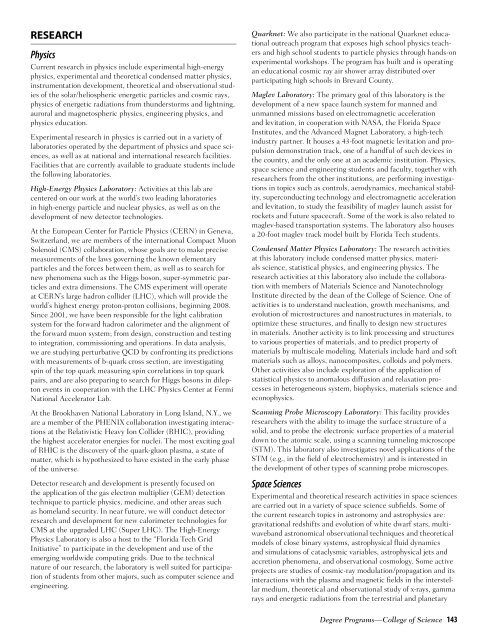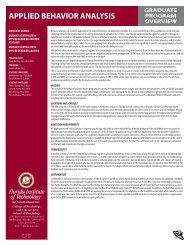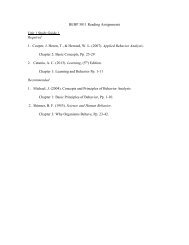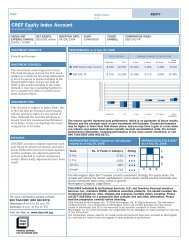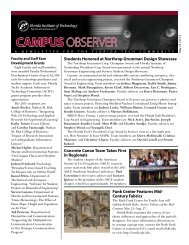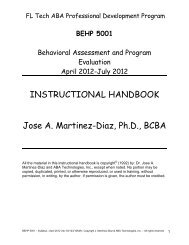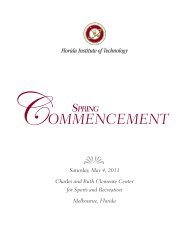2008–2009 - Florida Institute of Technology
2008–2009 - Florida Institute of Technology
2008–2009 - Florida Institute of Technology
You also want an ePaper? Increase the reach of your titles
YUMPU automatically turns print PDFs into web optimized ePapers that Google loves.
esearch<br />
Physics<br />
Current research in physics include experimental high-energy<br />
physics, experimental and theoretical condensed matter physics,<br />
instrumentation development, theoretical and observational studies<br />
<strong>of</strong> the solar/heliospheric energetic particles and cosmic rays,<br />
physics <strong>of</strong> energetic radiations from thunderstorms and lightning,<br />
auroral and magnetospheric physics, engineering physics, and<br />
physics education.<br />
Experimental research in physics is carried out in a variety <strong>of</strong><br />
laboratories operated by the department <strong>of</strong> physics and space sciences,<br />
as well as at national and international research facilities.<br />
Facilities that are currently available to graduate students include<br />
the following laboratories.<br />
High-Energy Physics Laboratory: Activities at this lab are<br />
centered on our work at the world’s two leading laboratories<br />
in high-energy particle and nuclear physics, as well as on the<br />
development <strong>of</strong> new detector technologies.<br />
At the European Center for Particle Physics (CERN) in Geneva,<br />
Switzerland, we are members <strong>of</strong> the international Compact Muon<br />
Solenoid (CMS) collaboration, whose goals are to make precise<br />
measurements <strong>of</strong> the laws governing the known elementary<br />
particles and the forces between them, as well as to search for<br />
new phenomena such as the Higgs boson, super-symmetric particles<br />
and extra dimensions. The CMS experiment will operate<br />
at CERN’s large hadron collider (LHC), which will provide the<br />
world’s highest energy proton-proton collisions, beginning 2008.<br />
Since 2001, we have been responsible for the light calibration<br />
system for the forward hadron calorimeter and the alignment <strong>of</strong><br />
the forward muon system; from design, construction and testing<br />
to integration, commissioning and operations. In data analysis,<br />
we are studying perturbative QCD by confronting its predictions<br />
with measurements <strong>of</strong> b-quark cross section, are investigating<br />
spin <strong>of</strong> the top quark measuring spin correlations in top quark<br />
pairs, and are also preparing to search for Higgs bosons in dilepton<br />
events in cooperation with the LHC Physics Center at Fermi<br />
National Accelerator Lab.<br />
At the Brookhaven National Laboratory in Long Island, N.Y., we<br />
are a member <strong>of</strong> the PHENIX collaboration investigating interactions<br />
at the Relativistic Heavy Ion Collider (RHIC), providing<br />
the highest accelerator energies for nuclei. The most exciting goal<br />
<strong>of</strong> RHIC is the discovery <strong>of</strong> the quark-gluon plasma, a state <strong>of</strong><br />
matter, which is hypothesized to have existed in the early phase<br />
<strong>of</strong> the universe.<br />
Detector research and development is presently focused on<br />
the application <strong>of</strong> the gas electron multiplier (GEM) detection<br />
technique to particle physics, medicine, and other areas such<br />
as homeland security. In near future, we will conduct detector<br />
research and development for new calorimeter technologies for<br />
CMS at the upgraded LHC (Super LHC). The High-Energy<br />
Physics Laboratory is also a host to the “<strong>Florida</strong> Tech Grid<br />
Initiative” to participate in the development and use <strong>of</strong> the<br />
emerging worldwide computing grids. Due to the technical<br />
nature <strong>of</strong> our research, the laboratory is well suited for participation<br />
<strong>of</strong> students from other majors, such as computer science and<br />
engineering.<br />
Quarknet: We also participate in the national Quarknet educational<br />
outreach program that exposes high school physics teachers<br />
and high school students to particle physics through hands-on<br />
experimental workshops. The program has built and is operating<br />
an educational cosmic ray air shower array distributed over<br />
participating high schools in Brevard County.<br />
Maglev Laboratory: The primary goal <strong>of</strong> this laboratory is the<br />
development <strong>of</strong> a new space launch system for manned and<br />
unmanned missions based on electromagnetic acceleration<br />
and levitation, in cooperation with NASA, the <strong>Florida</strong> Space<br />
<strong>Institute</strong>s, and the Advanced Magnet Laboratory, a high-tech<br />
industry partner. It houses a 43-foot magnetic levitation and propulsion<br />
demonstration track, one <strong>of</strong> a handful <strong>of</strong> such devices in<br />
the country, and the only one at an academic institution. Physics,<br />
space science and engineering students and faculty, together with<br />
researchers from the other institutions, are performing investigations<br />
in topics such as controls, aerodynamics, mechanical stability,<br />
superconducting technology and electromagnetic acceleration<br />
and levitation, to study the feasibility <strong>of</strong> maglev launch assist for<br />
rockets and future spacecraft. Some <strong>of</strong> the work is also related to<br />
maglev-based transportation systems. The laboratory also houses<br />
a 20-foot maglev track model built by <strong>Florida</strong> Tech students.<br />
Condensed Matter Physics Laboratory: The research activities<br />
at this laboratory include condensed matter physics, materials<br />
science, statistical physics, and engineering physics. The<br />
research activities at this laboratory also include the collaboration<br />
with members <strong>of</strong> Materials Science and Nanotechnology<br />
<strong>Institute</strong> directed by the dean <strong>of</strong> the College <strong>of</strong> Science. One <strong>of</strong><br />
activities is to understand nucleation, growth mechanisms, and<br />
evolution <strong>of</strong> microstructures and nanostructures in materials, to<br />
optimize these structures, and finally to design new structures<br />
in materials. Another activity is to link processing and structures<br />
to various properties <strong>of</strong> materials, and to predict property <strong>of</strong><br />
materials by multiscale modeling. Materials include hard and s<strong>of</strong>t<br />
materials such as alloys, nanocomposites, colloids and polymers.<br />
Other activities also include exploration <strong>of</strong> the application <strong>of</strong><br />
statistical physics to anomalous diffusion and relaxation processes<br />
in heterogeneous system, biophysics, materials science and<br />
econophysics.<br />
Scanning Probe Microscopy Laboratory: This facility provides<br />
researchers with the ability to image the surface structure <strong>of</strong> a<br />
solid, and to probe the electronic surface properties <strong>of</strong> a material<br />
down to the atomic scale, using a scanning tunneling microscope<br />
(STM). This laboratory also investigates novel applications <strong>of</strong> the<br />
STM (e.g., in the field <strong>of</strong> electrochemistry) and is interested in<br />
the development <strong>of</strong> other types <strong>of</strong> scanning probe microscopes.<br />
Space Sciences<br />
Experimental and theoretical research activities in space sciences<br />
are carried out in a variety <strong>of</strong> space science subfields. Some <strong>of</strong><br />
the current research topics in astronomy and astrophysics are:<br />
gravitational redshifts and evolution <strong>of</strong> white dwarf stars, multiwaveband<br />
astronomical observational techniques and theoretical<br />
models <strong>of</strong> close binary systems, astrophysical fluid dynamics<br />
and simulations <strong>of</strong> cataclysmic variables, astrophysical jets and<br />
accretion phenomena, and observational cosmology. Some active<br />
projects are studies <strong>of</strong> cosmic-ray modulation/propagation and its<br />
interactions with the plasma and magnetic fields in the interstellar<br />
medium, theoretical and observational study <strong>of</strong> x-rays, gamma<br />
rays and energetic radiations from the terrestrial and planetary<br />
Degree Programs—College <strong>of</strong> Science 143


